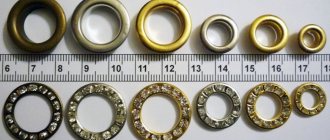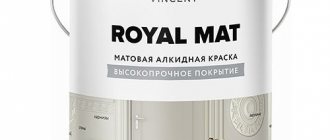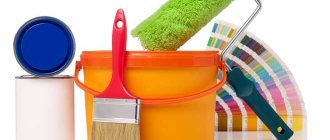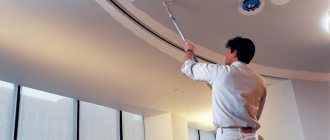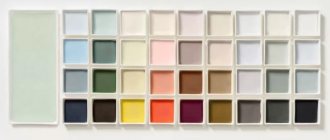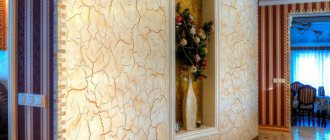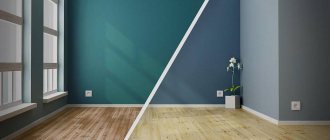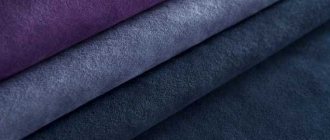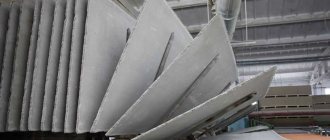How to choose paint
Before purchasing, you should pay attention to some characteristics of the paint:
- Compound;
- Consumption;
- Drying time;
- Best before date.
It's not for nothing that it's listed on the packaging. Over time, the paint simply loses its positive qualities and applying it to the wall will waste your time. During self-repair, I want it to move faster
Therefore, pay attention to the drying time, this will save time. Remember that the paint is applied in two layers
Drying time also depends on the temperature and humidity of the room. Manufacturers always indicate the material consumption on the packaging. However, this indicator will vary depending on the condition of your walls: smoothness, evenness, cracks, etc. The absorbency of your surface also plays a role. Concrete absorbs very well, so you may even have to apply three layers. To avoid this, coat the walls with a preliminary coat of primer. You can save on consumption by using tools: a brush takes up much more paint, a roller is smaller and a spray bottle will save your effort and material. When choosing, look at the price. Of course, you don’t want to spend a lot, but very cheap samples most likely do not differ in quality.
Pay attention to the weight. The density of the material is about one and a half kilograms per 1 liter of paint
Among the many manufacturers there are those who have already proven themselves. These paints include Dulux and Tikkurila.
What is water-based paint?
A water emulsion is a mixture of insoluble substances and liquid.
Polymers act as the first compounds in aqueous emulsions. A water emulsion is a mixture of insoluble substances and liquid. Polymers act as the first compounds in aqueous emulsions. When applied to the surface, the liquid evaporates, and insoluble elements remain and form a protective film.
Paint composition
Different types of water-based paint have different compositions. It affects the technical characteristics. In production we use:
- water is the base of paintwork materials, solvent;
- polymers responsible for film formation;
- antifreeze, which enhances resistance to low temperatures, which simplifies transportation and storage;
- antiseptic providing biological stability;
- defoamer, increasing fire safety;
- plasticizers to impart plasticity to the composition;
- dispersants that prevent sedimentation and separation of the composition during storage;
- pigment for tinting;
- density regulator, allowing you to keep the material in working condition longer.
Also, water-based paint may contain titanium and zinc compounds, which are responsible for the snow-white color. Some manufacturers use minerals in production. This allows you to reduce the cost, while worsening the performance parameters of paintwork materials.
GOST
When choosing water-based façade paint, you should pay attention to its compliance with the standard.
If GOST is indicated on the label, then the composition meets the approved parameters. When marking specifications, deviations from the standards are possible, which will affect the quality parameters of paintwork materials.
Paint characteristics
GOST 28196-89 describes the requirements for 4 types of water-based paints. The main parameters of aqueous emulsions are:
- The fraction of non-volatile substances indicates the amount of insoluble constituents. The standard specifies types of paints with low, medium and maximum levels of non-volatile substances. The greater their number, the thicker the composition, and accordingly, the thicker the coating layer.
- Water-based paint for facades should have a pH level of 6.5-9%. This number characterizes the level of acidity of the environment.
- Covering power shows how much paint is required to cover a color. According to GOST, the figure is 80-120 g/m².
- For resistance to water, the standard specifies 2 indicators. For VD-VA-224 paint it is 12, which allows the composition to be used in conditions of high humidity, for the rest - 24.
- According to GOST, the number of freezing cycles of the composition is 5.
- Lightfastness is important. Thus, facade water-based paint according to GOST must have a characteristic of at least 5. VD-VA-224 does not have light resistance, therefore it is used exclusively for interior work.
There are also other characteristics that the water-based emulsion must meet. The presence of the GOST mark should be taken into account when choosing water-based paint.
Best before date
The shelf life of water-based compositions is 2 years from the date of manufacture. It is important to strictly observe storage conditions. Open paint should be stored in a tightly closed container in a dark place, away from exposure to sub-zero temperatures.
Consumption
The costs of paintwork materials depend on the type of surface to be painted and the degree of its preparation, as well as on external conditions. The consumption of water emulsion varies. For single-layer painting, the figure is 110-150 g/m². There are formulations in which the cost per square meter is 200 ml.
How to speed up the drying process of paint?
Option 1
A special catalyst will help speed up the drying of oil paint. This product is called a desiccant. It is sold in the paint and varnish departments of construction stores. The drier is an accelerating element for polymerization, that is, its purpose is to ensure that the drying process does not take too long.
Salts of cobalt, manganese and calcium can be used as catalysts-accelerators-driers. Lead, zirconium and barium salts are often used. Salts of carboxylic acids are an ideal solution, although the modern market increasingly offers multi-metal mixed dryers that can be used for several types of paintwork materials and do not in any way affect their color and adhesive properties if you follow the included instructions.
The appendix will tell you how much drier you need to add per 1 liter so that the paint does not “curl” when applied, but simply dries faster. After using such an accelerator, difficult-to-dry oil compositions obediently polymerize. How long does it take for paint with drier to dry? Typically within 24-28 hours at room temperature.
Option 2
How to quickly dry oil paint if the catalyst application time has been missed and 2-3 layers of paint are already on the wall? I would like to believe that the layers are thin enough. If you prefer a spray gun to a roller or brush, which under pressure produces an even, thin, smooth layer, and the paint is distributed over a heated surface, then the drying time is significantly reduced.
Option 3
What else can you do to make the paint dry faster? Raise the temperature! High temperature is another catalyst to make the paint harden faster. At industrial facilities they use a heat gun, but for us a hair dryer or a regular infrared heater is enough. With this we will “kill two birds with one stone”: we will raise the temperature inside the room and lower the humidity.
Option 4
When the solvent evaporates, many odorous harmful substances are released, so many people advise creating a draft in the room. Ventilation will not only remove unhealthy fumes, but will also promote quick drying. Therefore, we open the doors and windows, turn on the fan, and place the heater in the middle of the room, in no case close to the wall.
The infrared waves of the heater must penetrate through the resulting film and oil base evenly, and also evenly heat the wall underneath. However, make sure that the temperature does not rise above 60 degrees, otherwise the “boiled” paint will simply burst and crack. This is definitely not our option!
On any composition (on the packaging) you can read that it must be thoroughly mixed before use - if you neglect this instruction, the binding components may remain at the bottom, making the coating incomplete.
It is also very important that the surface to be treated is dry and free of oil and grease stains, which can directly affect the drying time of the paint. Another reason for prolonged drying may be a violation of storage conditions - all paints have a critical negative temperature. Perhaps the composition you purchased simply froze, losing its properties
Are there “universal” paints with the same surface drying time?
The answer is clear - no. Universality is just a myth used by unscrupulous manufacturers solely for advertising purposes. At best, you buy paint with a one-time or very short-term effect. Therefore, you should not believe the manufacturer’s promises that the paint is equally ideal for repairing the paint surface of a car, for heating radiators, and for decorating a kitchen or bedroom. An excellent result will only be achieved if the paint is used for a specific purpose. In other cases, you will get a mediocre result and simply throw money away.
Often, when choosing, the decisive question is how long the paint takes to dry. This is objectively and directly related to its composition and the environmental conditions in which drying should occur. Why is it important? The pace of paint and varnish work has a direct impact on the overall speed of repair. For example, it is not recommended to carry out any other finishing work while the paint is drying. Otherwise, dust and other construction debris will simply stick to the painted surface.
Useful tips
Before you start painting, you need to remove all pieces of furniture. If this is not possible, you should cover it with newspapers or cloth. In addition, it is recommended to protect the floor with the material if no further alteration is planned.
It is not so difficult to remove water-based emulsion from clothes: if the stains are fresh, you just need to wipe the area where the paint got in with a solution of water and detergent in a 1:1 ratio. If the stain is old, alcohol or regular hairspray will come to the rescue. The product must be applied to a cotton pad and applied to the paint stain for a while, after this procedure the paint is washed off with plain water.
However, despite the fact that the paint can be easily washed off, when preparing for finishing work you should take care of protecting your clothes and wear a protective suit or some old wardrobe items that you don’t mind ruining.
Before carrying out work, it is important to carefully prepare the surface for it. It must be smooth and clean, so you must first remove all remnants of the previous coatings, putty and level the wall or ceiling, sand if necessary, and then wash, removing any remaining dust and dirt
After the layer of putty material has completely dried, the walls must be carefully primed.
It is necessary to apply paint in several layers. Depending on the manufacturer, there may be 2 or more. However, the best option is to apply 3 thin layers of material, with the direction of brush strokes or roller movements on each layer being different. The first layer must be applied parallel to the sun's rays falling through the window, the second layer must be applied perpendicular to the first, but the third must be applied moving in the opposite direction from the window.
If it is necessary to paint in different colors, it is necessary to use a white water-based emulsion and a color with the desired shade
Mixing the coloring matter should be done carefully and slowly: it is better to subsequently add the missing part of the pigment than to immediately get a shade that is too dark
Purpose of the material
Universal water-based paint
This type of paint does not contain solvents.
Therefore, it is non-toxic and does not have a strong unpleasant odor.
This indicates that there is no threat to the health of people and domestic animals.
Paint that has not had time to dry can be easily washed off with water: from hands and tools.
It fits perfectly on any surface.
It is very easy to apply to any surface. Exceptions are glossy areas.
But completely different materials can be applied on top of water-based paint.
To apply it you can use: brush, roller or spray. But before that it is better to prime the surface.
Such actions will help avoid corrosion. This type of paint has good vapor permeability. Which makes it suitable for painting concrete and even brick.
This type of paint is an excellent solution for covering many areas. But experts do not recommend painting glossy surfaces with it.
Water-based paint can deteriorate from direct exposure to the sun. Therefore, it must be stored away from their influence. The material does not have the property of spreading.
It will be an excellent solution when painting walls or ceilings. Water-based paint is very environmentally friendly, therefore it is widely used in all residential areas.
This paint is absolutely non-toxic. In addition, it is quite easy to wash off your hands. The painted surface never stops breathing.
Water-based paint is a durable material. It sits well on the surface and does not fly off after drying.
What do we see if acrylic paints have dried?
Acrylic paint contains three components: pigment, binder and water. Copolymers or acrylates are used as binders. The paint dries very quickly and after drying forms an elastic, plastically resistant coating, has good covering properties and excellent color brightness. Acrylic paints, unlike watercolors, do not fade in the sun and do not fade over time, like oil paints.
During the process of water evaporation, acrylic paint dries, after which it forms an elastic film of pigment and binder. Dried acrylic is very durable, it is not brittle and does not form cracks, and the painted surface does not flake. Over time, acrylic does not wrinkle, it is resistant to changes in humidity conditions and temperature changes. Its light resistance has been tested over more than fifty years of existence.
When applied in a thin layer, the paint dries almost instantly, thicker layers dry more slowly - up to several minutes. Once dry, acrylic paints cannot be removed with water and do not respond well to scraping or sanding.
Can you dry acrylic paint with a hairdryer?
There are restrictions on using a hairdryer. It can only be used for drying porous surfaces. Moreover, the paint or primer based on it must be sufficiently absorbed into the base and adhere to it. The hairdryer should not be turned on immediately after applying the paint; you need to wait at least 15-20 minutes. If you use an electrical appliance to dry smooth painted surfaces, especially with hot air, the paint will peel off. It turns out that the hairdryer will quickly dry the top layer, and the heated liquid paint will remain under it. It's like heating a corked bottle of champagne or soda. There will be an explosion. Also, the hairdryer should not be placed closer to the painted surface than 20-30 cm. If the priority is quality with the durability of the coating, then the hairdryer should be abandoned. The proverb “if you hurry, you make people laugh” is just about such cases. The most justified use of a hairdryer is when painting with multi-colored paints. A stream of warm air is used to dry locally applied paint of one color so that the next layer of a different color does not mix with the previous one. Those. so that there are no blurred boundaries.
Construction hair dryer
How long does acrylic paint take to dry?
The contours are applied directly from the tube with light pressure. The pasty mass forms a relief line. The thickness of the line is adjustable: if you tighten the compression of the tube and move it along the fabric slowly, the line will be thicker.
Fixing paints with an iron The finished product is ironed with an electric iron with a thermostat, at a temperature characteristic of the fabric used. The product is ironed from the wrong side. Today there is an opportunity to quickly learn how to decorate fabric. Everyone can try themselves in creativity. Invent, decorate, make things unique.
Important nuances of working with acrylic paint
When tinting with pigment paste and mixing shades, it should be taken into account that after the moisture has completely evaporated, the color of the coating becomes slightly darker and richer.
The material should be diluted moderately. When adding more than 20% water, adhesion is reduced, which can lead to peeling of the coating after drying. When applying a composition diluted with water, a translucent layer is obtained, through which the base or a previously applied pattern is visible. This allows you to get smooth transitions and other effects. If it is necessary to reduce the viscosity of artistic paint while maintaining the intensity of coloring, use a special thinner instead of water.
To obtain a smooth surface, the walls and ceiling are first puttied and treated with sandpaper.
Matte paint will help hide sanding flaws. It is not advisable to apply acrylic over an oil or alkyd layer, but it fits well on water-based emulsion and latex.
Before painting, the base is cleaned of traces of dust and grease.
How to degrease the surface:
- white spirit is suitable for fiberboard, chipboard, metal;
- alcohol - for plastic, glass, stone, leather;
- universal product - for various materials, except for some types of plastic.
To prevent spreading and uneven absorption of the water-polymer dispersion during painting, it is advisable to pre-prime a surface with high absorption capacity. Smooth materials (metal, plastic, glass) are painted with acrylic only after priming, otherwise the coating will not adhere well.
In some cases, for example when working with foam plastic, additional polishing (on the ground) is required. Painting begins after the substrate is completely dry. To protect the finished composition from possible damage, it is coated with acrylic varnish.
Features of oil paint
Experts divide oil paints into two large types - thickly rubbed, which require preliminary dilution with drying oils, and ready-to-use, which can be immediately applied to the surface.
They contain pigments that give a certain color, and synthetic or natural drying oils. Despite the name, oil paints are made from drying oil, which in turn is extracted from vegetable oils.
As a rule, in apartments, paint is used to decorate bathrooms and kitchens. The painted surface is easy to clean and remains perfectly protected not only from mechanical damage, but also from drying out and the process of rotting, if we are talking about wooden surfaces treated with paint.
You need to work with oil paint carefully, avoiding contact with human skin. If drops get on the walls, they can be quickly removed with a solvent
When working, it is important to ensure a constant supply of fresh air; the composition has a very specific odor that can irritate the human mucosa
In order to properly dilute paint, they often use not only drying oil, but also solvents such as turpentine and acetone. If you choose this option, you need to remember the main rule: the percentage of solvent cannot exceed 5% of the total mass of paint.
Variety of palettes
Acrylic is known for not being able to dissolve once completely dry. None of the known materials helps in resolving the issue. Therefore, you should not use the composition in conjunction with porous structures on which any other paint adheres well. Wood, even with a good varnish coating, will also be a bad choice. Glass doesn't work either.
Don't forget about additional recommendations:
- The surface must be clean and free of grease before being treated with acrylic paints. This applies even to completely new products and materials.
- Acrylic paints generally penetrate well into any type of structure. This means that it is better to pre-coat the surface with a primer. Then the result will be noticeably better.
- One of the main advantages of acrylic paints is the ability to choose absolutely any color; the available palette is truly rich. The main thing is to remember the ability of open air to increase drying time. This is especially important for those doing mixing or if glass is used.
Paints that have been thinned before starting work take longer to dry. At the same time, there is still no universal parameter; you must carefully study the instructions every time. It helps to study the accompanying documentation, which should also be attached to the compositions. It doesn’t matter what kind of packaging is used in a particular case.
More about acrylic paints (2 videos)
Acrylic-based wall paint (25 photos)
What factors affect drying time?
How long acrylic paint dries depends on the rate of evaporation of water from it. And this process is influenced by:
- temperature,
- air humidity,
- air speed,
- Atmosphere pressure,
- base structure,
- thickness of the paint layer.
Temperature
The range of 18-24°C is optimal for the evaporation of water and other solvents from the coloring composition. At 10°C the evaporation of water practically stops, and at 0°C it begins to turn into ice, which destroys the film. In hot conditions, at temperatures above 24°C, the lower layers of paint do not have time to dry after the upper ones. As a result, a liquid composition remains under the dried solid film, which, evaporating, breaks the film. Those. the coating is cracking.
Airflow speed
A thick cloud of vapor forms around the drying surface; air humidity near the freshly painted surface quickly increases, which slows down further evaporation. The more intense the air movement that blows the vapor cloud, the shorter the drying time of acrylic paint.
Atmosphere pressure
There is a direct relationship - the higher the atmospheric pressure, the faster the paint dries. Water molecules seem to be “squeezed out” more strongly from the base.
Base surface
Bases that intensively absorb moisture speed up the drying of water-soluble paint. The same acrylic composition on a plastered, puttied surface, paper, drywall or canvas does not dry as long as acrylic paint dries on wood, metal, plastic or glass. From smooth, water-repellent surfaces, evaporation continues several times longer.
Paint layer thickness
This parameter directly affects how long the paint composition will dry. You can reduce the thickness of the paint by adding a small amount of water or solvent.
How does the material harden?
Acrylic paint initially contains a hardener, due to which the polymerization reaction is activated when the composition is applied to the surface. The material of manufacture in this case does not matter. Ambient temperature is the main catalyst that initiates the reaction. The higher the temperature, the less time it takes to dry completely.
When performing work inside and outside, it is often possible to achieve surface heating of up to 25 degrees, or even higher. This certainly does not lead to instant drying of the material. Drying time increases. It is better to use special equipment if possible.
On video: what is acrylic paint?
Advantages of the composition
- The paint is based on polyacrylic substances, which form a durable, opaque film on the surface. For facade and interior finishing work, water-dispersed compositions are used, so the paints have virtually no odor and dry quickly.
If we look at it in detail, they consist of:
- From film-forming. a binder polymer that provides good adhesion to the base and holds fillers, pigments and other substances.
- From pigment. which is presented in the form of particles of a fine fraction and is responsible for the color, strength and corrosion resistance of the composition.
- Fillers are responsible for the visual effects on the surface, that is, gloss or matte. Also provide protection against pests, mold, mildew, water resistance and added durability.
- Small amounts of auxiliary elements such as thickeners, defoamers, stabilizers, emulsifiers, etc. are necessarily present.
- A distinctive feature of acrylic is that until the paint has set, it can be easily washed off with plain water, but after hardening, a durable film is formed on the surface, resistant to moisture and aggressive influences. It can only be removed using special solvents.
Color range of acrylic paint.
Important: perhaps the most important advantage of acrylic coating is that the composition is vapor permeable, the wood under such a coating breathes. But at the same time, it reliably protects the base from pests.
What is acrylic paint: distinctive features of the composition
Acrylic paint is one of the types of water-based compositions. It replaced the oil coating. This paint is characterized by high performance qualities, thanks to which it provides reliable and durable protection of the wooden surface, giving it an aesthetically pleasing decorative appearance.
Acrylic compositions are water-based, they are characterized by reliability and durability
A distinctive feature of this composition is the water-solubility of the material, due to which the paint can be removed with water until the surface is completely dry. After the paint has completely set, it forms a protective, durable, moisture-resistant layer that is characterized by good elasticity. This feature allows the surface not to react to temperature changes and fluctuations in air humidity.
Possessing a unique composition, acrylic paints are characterized by a rich, bright palette of shades that do not fade or fade over time. The material can create a matte or glossy surface. There are also paints that imitate wood, satin or velvet. In addition, certain components eliminate the likelihood of cracking of the painted surface. The demand for this composition is also explained by the lack of toxicity and safety for human health.
Important! There is acrylic paint of a transparent color, thanks to which it will be possible not only to protect the surface, but also to emphasize its unique texture and natural shade.
Tips for working with oil paints
- Today, matte surfaces are in fashion, so the following method is often used to impart this property to the coating:
- A soap solution is prepared in the proportions of 40% laundry soap to 60% water. A piece of soap grated on a coarse grater (100g) is poured with warm water and heated, stirring, until completely dissolved;
- the resulting substance is added directly to the coloring composition, stirred thoroughly, and a matte finish is ensured.
- Oil paint should not be filtered if a film has formed on its surface. It is extremely undesirable to try to stir it: this can ruin the entire material. It’s better to take a piece of gauze or nylon and try to cover the frozen surface with it, and then drown the resulting lump.
- In order to qualitatively restore a wall that was previously painted with such paint, but is in poor condition, you need to remove the old coating, putty the surface, prime it with drying oil and only then apply a fresh color.
- You can get rid of the old layer using a spatula or scraper, after wetting the wall with water; A drill with a special attachment or a hair dryer can speed up this process.
- If the quality of the old surface is in perfect order and you only need to update it by changing the shade, then you can paint directly over the previous layer, having first washed off all the dirt.
- To lighten the shade, add a small amount of chalk to the paint, ground into homogeneous flour.
- If you place large containers of salt water in the room where repairs are being made, the specific and pungent odors will disappear faster.
- To protect the floor from contamination with oil paint, you can lubricate it with a thick soap solution, which will prevent corrosive drops from being absorbed into the surface, and they will be very easy to remove. An easier way is to cover the floor with newspapers.
- When the remains of the coloring composition are to be stored for a long time, it is recommended to pour a little vegetable oil (a thin layer) into the container with it; it will not allow the material to dry out.
- It is advisable to place new brushes in water for about two days; this way they won’t lose hair while working.
- After use or dried brushes can be washed well if left for some time in a solvent (kerosene, turpentine or ammonia).
Features of acrylic compositions
This paint is a water-acrylic dispersion. It does not contain harmful impurities, has no pungent odor, and does not emit caustic fumes either during application or after drying. To dilute the liquid paint material, purified water is used; professional artistic compositions in some cases require the use of a special diluent.
The dried layer retains elasticity, does not crack or crumble. It is not washed off with water and does not absorb dirt particles, but remains permeable to air and water vapor.
Other paint features:
- wide range of colors, possibility of independent tinting;
- ease of application;
- high level of adhesion;
- the ability to create smooth and textured surfaces;
- good hiding power, which ensures economical consumption;
- speed of hardening;
- resistance of the finished coating to abrasion, dampness, UV rays (does not fade), and many solvents;
- fresh stains are easily wiped off, tools are cleaned with water.
The dispersion exhibits adhesive properties, which can be used, for example, in scrapbooking. Other types of paints and graphic elements fit well on top of the frozen layer.
Table of different types of paints and their characteristics.
Surface treatment
Applying water-based paint to drywall
These types of paint dry quite quickly.
Therefore, if you move the brush in one place for a very long time, the putty will begin to fall off.
A similar defect can occur due to poor putty or lack of primer.
Water-based paint is well absorbed into the surface due to its properties.
Of course this is very good.
Moreover, it contains an antiseptic.
The only downside is that the surface remains unpainted.
There is little joy in instant drying. Because this does not happen evenly.
Consequently, after drying it may appear in the form of streaks and stains. Consequently, you will have to paint several more layers on top to hide the resulting defect.
Another interesting question is how long it takes for water-based paint to dry on drywall. Here it will dry instantly, simply because it will be absorbed immediately.
Of course, this is a personal matter for everyone. Just remember that in the absence of a primer, the paint itself will play its role. If it is liquid and the surface is porous, it is impossible to guess how many layers will be needed.
Therefore, it is better not to try to save money in this matter. It will be more expensive. In addition, painting will take much more time. Layers of this paint should absolutely not be applied at once.
This can cause the under-dried layers to stick together and begin to fall off in pieces. After this, they will have to be cleaned completely. And therefore paint again.
In the video you can see how to paint a ceiling with water-based paint:
Noticed a mistake? Select it and press Ctrl+Enter to let us know.
Types of water-based paints
The production of water-based emulsions is now actively developing, and on the market you can find water-resistant , matte, detergent and colored .
It is difficult to say which water-based paint is better . Each has its own purpose and its own advantages.
As we said above, the type depends on the binder polymer in the composition. There are four types of water-based enamel:
- Silicone;
- Acrylic;
- Silicate;
- Mineral.
Silicone is called so because it contains silicone resins. Its use is not limited to masking large cracks. It is also moisture-resistant and sometimes water-resistant, which is especially useful in areas where mold may form.
It cannot be said that acrylic is the best water-based paint, but yes, it is the most popular. This is interior paint . Latex is often added to its composition, which makes it waterproof and glossy. It also masks cracks up to 1 mm thick and covers the surface easily due to its thickness. Water-based coating can be washed up to 5 thousand times and will not wear off, so it is most beneficial for painting a bathroom or kitchen. Such glossy paints have a vapor permeability feature that will protect the walls from fungus. Has high density .
The main disadvantage is the relatively high price.
Silicate - a mixture of liquid glass, water and dye. Pros:
- Long service life;
- Temperature resistance;
However, it is not at all moisture resistant..
Mineral is used for any work, but has a short service life. It is not washable and the painted surface can be easily damaged.
Primer drying time
The minimum period of time during which the primer composition dries is 4 hours, the maximum is a day. Despite the fact that the packaging necessarily contains information about how long the primer takes to dry, the waiting time after its application can vary, and quite significantly.
Factors affecting the drying speed of the primer:
- Mixture consumption and layer thickness depend on the condition of the surface being treated. There are walls that require repeated priming or application of the composition in a thick layer.
- Type of primer - acrylic emulsions are quick-drying and require 3-4 hours to dry; oil or contact emulsions dry up to 24 hours.
- The type of surface being treated is porous and dry, it dries quickly, and with freshly applied plaster – about 12 hours.
- Temperature in the building and humidity level - the lower the air temperature in the rooms and the higher the humidity, the longer the drying period of the primer composition. For example, after applying Betonokontakt to the walls at a temperature of 23°C and a relative humidity of 50%, you can begin gluing wallpaper after 12 hours, and if the temperature drops to 20°C and the air humidity rises to 65%, finishing work can begin only after 24 hours.
FAQ
When carrying out painting work with water-based paint, a number of questions arise for the craftsmen. Here are the answers to the most common ones.
How to dilute water-based paint
Water is used to dilute the emulsion. The tap liquid should stand for 2 hours before diluting. When using a spray gun, it is better to use special thinners, which are offered by hardware stores. With their help, it will be possible not only to properly dilute the composition, but also to give it a glossy or matte effect.
Is it possible to paint ceiling tiles?
Certain types of ceiling tiles can be painted with water-based compositions. This applies to foam plastic. At the same time, there are options on the construction market for painting which exclusively use alkyd compounds.
Is it possible to apply putty to water-based paint?
It is not recommended to putty over water-based emulsion, since the paint can absorb water from the putty mixture. Over time, this will cause the putty to peel off and cause additional costs for re-repairs. It is better to remove the coating from the surface, especially since this is not difficult to do.
How long does it take for water-based paint to dry on walls?
Depending on the type of paintwork and the type of base, drying time varies from 2 to 24 hours. Temperature and humidity also affect this indicator. When painting with multiple layers, after just a couple of hours you can apply a second layer. Final drying occurs after 12-24 hours.
How to tint water-based paint
A white water-based emulsion is poured into a small container (approximately 100 ml). Add 2-3 drops of color to the prototype. The paint is thoroughly mixed to a uniform shade. If it is necessary to change the color, add more color, 1 drop at a time. Having received the desired shade, it is calculated how much pigment is required for the entire available volume of paint. 20% should be subtracted from the resulting amount, since after drying on a large area of the wall, the shade will be more saturated.
Working with water-based compositions is a pleasure: they do not smell, dry quickly, and are easy to apply.
If the material is used correctly, you can achieve a beautiful coating with a long service life and good protective characteristics.
How to dilute acrylic paint if it has dried?
In some cases, it will not be possible to dilute acrylic paint; the manufacturer must indicate this on the packaging. The required thinner is also indicated there. In the case where the packaging has not been preserved, you can use a universal solvent for acrylic resins. Since solvents can be glossy or matte, be sure to inform the seller about this when choosing. The solvent is added in small portions to the dried paint, after which it is necessary to knead it until the lumps completely disappear.
To restore acrylic paint, you can use warm alcohol with water or vodka, but before diluting all the paint, you need to experiment with a small amount of paint. As experts advise, it is better not to experiment, but to buy a special solvent, while the paint will completely retain its original color.
When the paint is completely dry, it must be kneaded to a powder state. Then you need to pour boiling water into the paint container. When the water has cooled, it should be drained through cheesecloth. This procedure must be repeated several times until the paint absorbs the required amount of water. After each heating, the paint must be stirred until it becomes sufficiently liquid.
It is very difficult to dilute heavily dried acrylic paint, but one must remember that its original qualities will not be fully restored, even if the desired thickness and uniformity is achieved. First of all, the shade of the paint may change; it will no longer apply so smoothly and will have an uneven color, which is very noticeable on large surfaces to be painted. They are quite suitable for painting small surfaces, but it is still better to purchase new paints or prevent them from drying out completely, checking them periodically and diluting them if necessary.
Types of acrylic paint for wooden surfaces
Acrylic paint for wood is classified into materials for interior and exterior use. The composition of the coatings is practically the same, with the exception of the presence of a special additive in the paint for facade work, thanks to which the surface is protected from exposure to ultraviolet rays and temperature fluctuations. In addition, this surface is moisture resistant.
Acrylic paints can be classified in more detail. There are facade compositions that are intended for painting individual wooden structures and walls, universal materials for interior work, universal decorative products and paints that are used for finishing wooden floor coverings.
Acrylic paint can be used for external and internal elements
The scope of use of acrylic paint is indicated on the packaging. Compositions for different purposes are not interchangeable, since they differ in individual characteristics.
Painting materials, which are intended for the treatment of external structures, contain copolymers consisting of styrene and methacrylic acid. Such a coating will be highly durable, but will have a reduced level of moisture absorption.
Some acrylic compositions that are intended for finishing facades cannot be used for painting wooden surfaces indoors. For example, floor enamel is characterized by high abrasion resistance. However, it will be susceptible to ultraviolet radiation and temperature fluctuations. Facade paint is not suitable for floors, as it is not designed for walking on, so the surface will quickly deteriorate.
To carry out painting on wood or restoration work, you will need a special acrylic composition that is intended for this.
Exterior paint is more durable
Painting products are produced mainly in buckets of 3, 5, 7, 10 and 20 liters. There is acrylic paint for wood in cans, made in aerosol form. It is very easy to apply, especially for treating small areas.
Helpful advice! Aerosol paint for wood is used primarily for decoupage.
Rules for working with quick-drying (express) varnishes
As you know, the main characteristic of express varnishes is high drying speed. This increases the productivity of repair operations, but does not allow applying such varnish to the entire body (due to the short drying time between layers and the risk of “over dusting”). The main area of application for such varnishes is quick repairs of 1-2 elements.
Also, quick-drying varnishes are in demand by repair shops that have problems with temperature conditions and the presence of dust in the paint shop. The rapid “dust” drying of such varnishes allows for high-quality painting outside the spray booth, with a minimum number of dust inclusions, which subsequently need to be polished.
When working with quick-drying materials, the first thing to remember is that they have a very short “lifetime”. Therefore, it is necessary to dilute the “quick” varnish only immediately before use, and in no case in advance. Only when the base has dried and the surface is ready for varnishing can you prepare the varnish and apply it immediately.
When applying, you need to carefully monitor the entire process.
Since the varnish dries very quickly, it is important to apply the first coat properly. If it is applied poorly, it will be extremely difficult, and sometimes impossible, to correct the situation with a second layer.
We looked at the techniques for working with the main types of clear varnishes that are used today in auto repair. We will talk separately about some varnishes that were left outside the scope of the article (for example, ceramic).
To summarize, I would like to remind you once again that varnish is the final layer of paintwork, and by its appearance the consumer often judges the quality of the repair as a whole. At the same time, varnish is only part of the paint and varnish system, and the result of painting is highly dependent on many other factors, for example, on the technique of applying the base enamel layer. But this is a separate conversation.
General factors that have the same effect on the drying of any paint
Of course, the paint base has a direct impact on drying speed. But, in addition to this, you should also take into account external factors, the influence of which determines how quickly the mixture hardens:
- Surface porosity. The larger the capillary structure of the material being painted and the amount of paint that gets inside, the longer the drying time. For example, the same paint dries faster on metal than on wood. To close the pores and create an evenly homogeneous surface, various primers are used.
- The ambient temperature also affects the rate of evaporation of the components included in the paint. However, excessively high temperatures may not cause acceleration of polymerization, but, on the contrary, make the composition more liquid and, accordingly, slow down the drying rate. Manufacturers usually indicate the temperature range acceptable for applying paint.
- Ambient air humidity. Some paints and varnishes do not release moisture well in humid air, which increases the drying rate.
- Availability of ventilation. All paints dry faster with more active air movement. However, drafts are contraindicated - a more competent solution is to use a forced supply and exhaust ventilation system, balanced in volume and speed.
- Another factor is the thickness of the paint layer applied to the surface. The thicker the coating, the longer the drying process.
